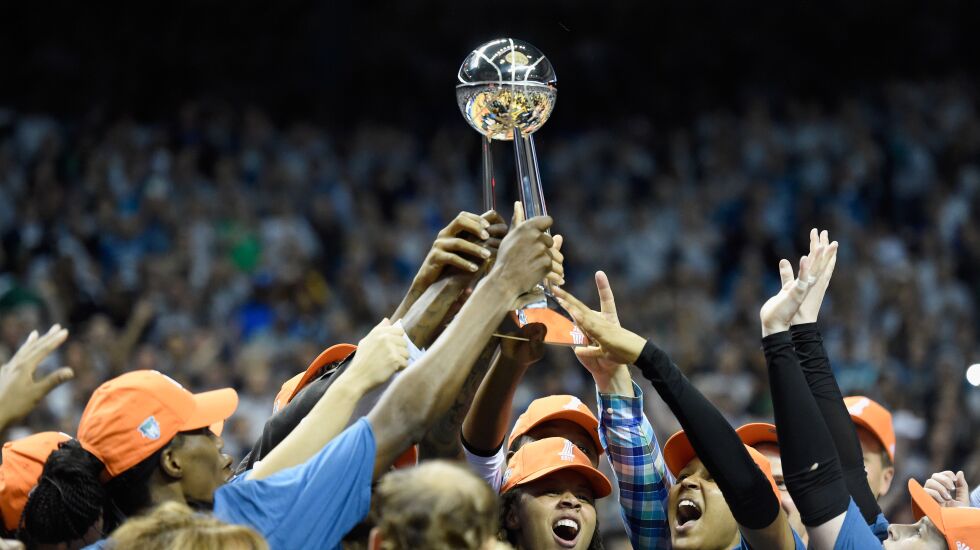
Super teams have defined the WNBA since the league’s inception in 1997.
The defunct Houston Comets set the super-team standard, winning the league’s first four titles behind Sheryl Swoopes, Cynthia Cooper and Tina Thompson.
Lisa Leslie led the Los Angeles Sparks on a two-year tear that included back-to-back titles with Delisha Milton-Jones. In 2007, Diana Taurasi, Cappie Pondexter and Penny Taylor led the Mercury to the first of their two titles in three years.
Two seasons after that, it was the Minnesota Lynx who would carry the super-team torch, playing in six WNBA title games in seven years and winning four. Cheryl Reeve’s teams from 2011 to 2015 included league legends Maya Moore, Seimone Augustus, Lindsay Whalen and Rebekkah Brunson. In 2015, the formidable became unstoppable when Reeve added Sylvia Fowles to the mix.
“Super teams have always happened,” Taurasi said during Team USA camp in February. “Since back in the day when you had the L.A. teams, we’ve had one a couple of times, Minnesota. It’s always happened. There are always periods in sports where a collective mindset of people come together and want to do something.”
As the league enters its 27th season, all of the aforementioned players have retired with the exception of Taurasi, who will play in her 19th season in 2023. But the super teams are alive and well, with some credit belonging to the Sky.
When the smoke cleared on this year’s free-agency period, there were two landing spots for the collective group of stars, the New York Liberty and the Las Vegas Aces. Both picked off the Sky’s championship players.
After years of saying she never would play for a franchise other than the one that drafted her or her hometown Sky, Candace Parker signed with the reigning-champion Aces. Courtney Vandersloot, the Sky’s franchise player who stayed through years of other stars’ departures, left for the Liberty.
The Aces and Liberty didn’t stop there. Breanna Stewart also said goodbye to the franchise that drafted her, the Seattle Storm, to go for a title with Vandersloot in New York. A day after signing Parker, the Aces added more depth by signing two-time WNBA champion and 11-year veteran Alysha Clark.
The unprecedented free-agent activity is the direct result of a collective-bargaining agreement ratified in 2020 that better facilitates player movement.
“It’s something we’ve aimed for, for a long time as players, having that freedom of movement to make decisions for yourself, your family and your career,” Taurasi said. “Sports are a funny thing. You get drafted to a place and you have this loyalty to them for giving you the opportunity. But it’s a catch-22. It’s amazing that players have the opportunity to go where they want.”
So what is it that makes this year’s crop of super teams more noteworthy than all the years past?
The answer is layered. For starters, Vandersloot is one of the players whom many expected to remain loyal to the franchise that drafted her, exemplified by the disbelief from fans when she signed with New York.
These moves also symbolize an elite status that the two franchises are attempting to establish by investing in facilities, training staff and amenities that set them apart. But most significant of all, the reasons these moves have garnered such a buzz is the fact that the Aces are tied up in not one, but two investigations into team conduct connected to free agency.
“It was a different time when we had our super team that was built naturally,” Reeve told the Sun-Times in February during the USA camp. “If things are done the right way, sure it’s good for the teams that acquire players. As long as the playing field is level in free-agency battles, and right now it’s not. We have to figure that part out.”
Four months after their first WNBA title, the Aces came under investigation after Sparks forward Dearica Hamby shared a post on social media alleging she was bullied and manipulated by her former team. Weeks later, Howard Megdal reported the Aces were being investigated by the league for circumventing the salary cap by making under-the-table offers to free agents.
As the rest of the league waits to hear what ramifications the Aces will face if the investigation does find the franchise at fault, the buzz around this budding rivalry continues to build.
Those rivalries are what have propelled the WNBA forward year after year. From the battles between the Comets and Liberty in the league’s early years to the Finals showdowns between the Lynx and Sparks, contention has proved to be valuable.
Super teams are the reason for it all.







